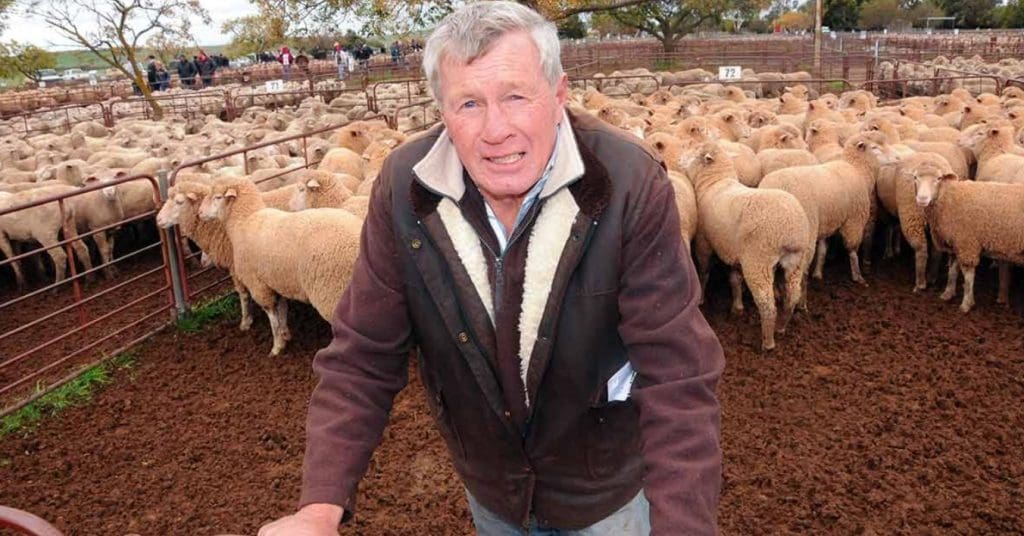
National Wild Dog Action Plan Coordination Committee chairman and wool grower Geoff Power.
URGENT trapping of wild dogs has been called for in south-east South Australia, adjacent to parklands in north-west Victoria where dingoes are now protected.
Reflecting concerns that more Victorian dingoes might now cross the border into south-east South Australia, National Wild Dog Action Plan Coordination Committee chairman and wool grower Geoff Power said wild dogs don’t respect state lines.
The coordination committee this week said it was pleased by the Victorian Government’s announcement to continue the dingo unprotection order in eastern Victoria; however, dingoes are still protected in the north-west of the state.
‘We’re well aware that wild dogs don’t respect state lines.
“Over the border in Ngarkat Conservation Park in South Australia – which is connected to the Big Desert Wilderness Park in Victoria – recent surveys for wild dogs recorded signs of at least 21 dogs by a professional trapper, in just one small section of the park,” Mr Power said.
“Given the density of dogs in Ngarkat Conservation Park, I will be recommending to the South Australian Government that professional trappers are engaged in this area with urgency, in line with SA policy for management of dingoes inside the fence,” he said.
The committee is also calling on the Victorian Government to review all the available data and revisit the end of the dingo unprotection order for the north-west of the state.
The committee said the ceasing of the dingo unprotection order in north-west Victoria in March continues to threaten the livelihoods of livestock producers across Victoria and South Australia, with several reports of producers in the region struggling with the impacts of wild dog attacks.
Mr Power said the Victorian Government decision was based on questionable wild dog population estimates, leaving sheep and cattle producers in the region ill-equipped to prevent attacks on their livestock.
“We’ve repeatedly requested to view the scientific report the Victorian Government based their decision on, with no response.
“As chair of the National Wild Dog Action Plan Coordination Committee, the reluctance of the Victorian Government to share the report is alarming and raises concerns about the validity of the science used to justify their decision,” Mr Power said.
The committee and livestock industry stakeholders have also requested the Victorian Government undertake a peer review of the paper that informed its decision – in line with standard practice to inform policy settings – and look forward to seeing results from this review if undertaken.
“It’s not just Victorian farmers who are impacted.
“There is real concern being felt by South Australian farmers, with 80pc of livestock in South Australia residing in the south-east of the state – right on the verge of the unprotection order in north-west Victoria.”
The National Wild Dog Action Plan Coordination Committee said it will continue to actively engage with the Victorian Government on this issue, to ensure livestock producers in Victoria and South Australia are appropriately protected from the very real impacts of inadequate wild dog control measures.
For more information on Australia’s approach to wild dog control, visit the National Wild Dog Action Plan website here.

A recent Freedom of Information request to PIRSA has revealed a discrepancy in the reported number of “wild dogs” in the Ngarkat. While Geoff Power claims ‘recent surveys for wild dogs recorded signs of at least 21 dogs,’ the actual FOI documents indicate a more accurate figure of 21 wild dog “tracks” detected. This clear misrepresentation highlights the importance of relying on verified data rather than exaggerated claims.
The claim of 21 dingoes being identified in a “small section” of Ngarkat raises serious concerns for those familiar with the population’s status. Given the documented decline of dingoes in Ngarkat due to intensive baiting and trapping, and estimates of less than 100 individuals across the entire Big Desert/Wyperfeld region over the border, this figure appears significantly inflated.
It’s crucial to consider the potential motivations behind such a claim. Job security for those involved in dingo control efforts could incentivise the exaggeration of dingo numbers. This unfortunately echoes past instances where PIRSA employees have overstated data.
Regarding Geoffrey’s request for the DEECA report, the information is readily accessible to the public. A simple online search for “DEECA Dingoes” will lead him directly to the relevant webpage.
Dingoes are classified as a native species at a federal level and by all mainland state governments.
Surely we can find ways to protect livestock without killing dingoes. Are we not innovative enough to move beyond just killing everything?
Dingoes are not a native species and should be treated like any other feral animal.